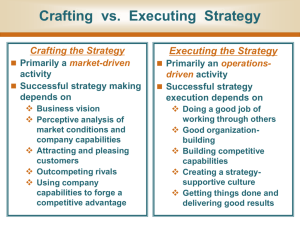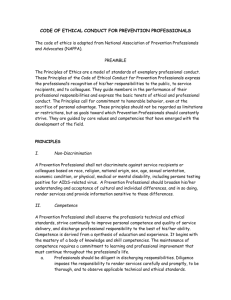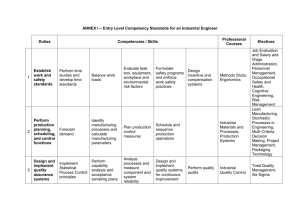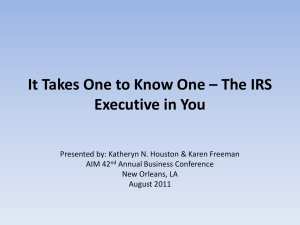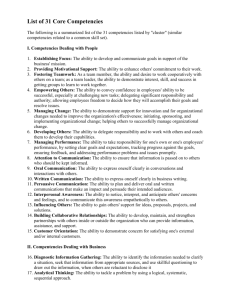Crafting vs. Executing Strategy Executing the Strategy Implementing
advertisement
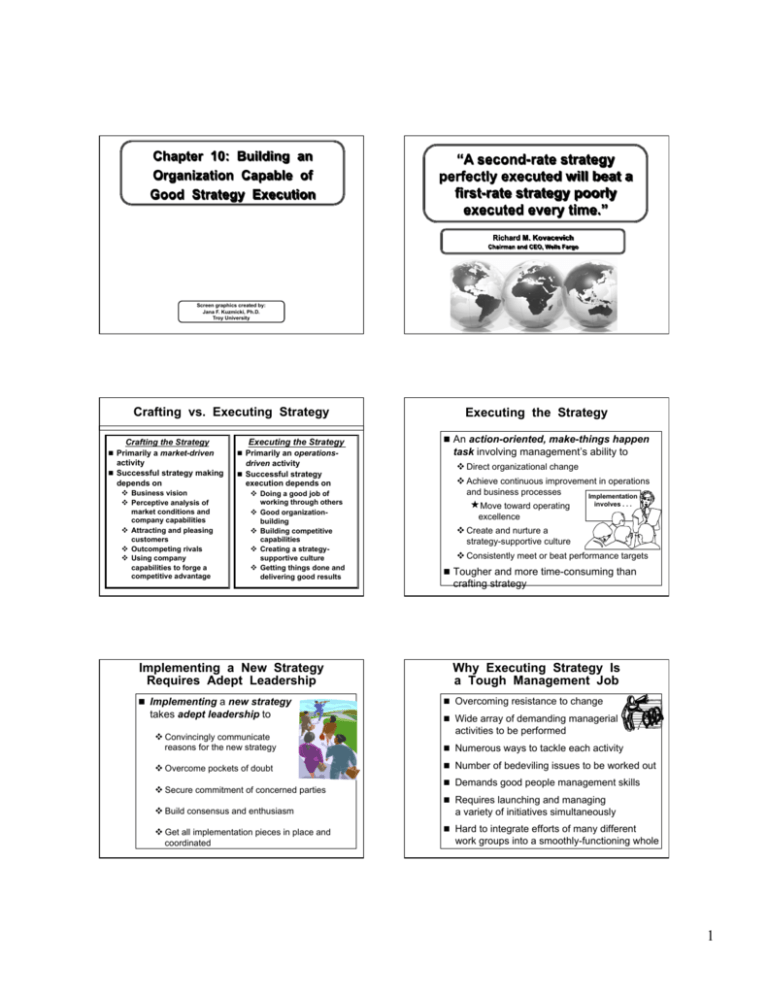
Screen graphics created by: Jana F. Kuzmicki, Ph.D. Troy University Crafting vs. Executing Strategy Crafting the Strategy Executing the Strategy Primarily a market-driven Primarily an operations- activity Successful strategy making depends on Business vision Perceptive analysis of driven activity Successful strategy execution depends on Doing a good job of market conditions and company capabilities Attracting and pleasing customers Outcompeting rivals Using company capabilities to forge a competitive advantage working through others Good organizationbuilding Building competitive capabilities Creating a strategysupportive culture Getting things done and delivering good results Implementing a New Strategy Requires Adept Leadership Implementing a new strategy takes adept leadership to Executing the Strategy An action-oriented, make-things happen task involving management’s ability to Direct organizational change Achieve continuous improvement in operations and business processes Implementation Move toward operating involves . . . excellence Create and nurture a strategy-supportive culture Consistently meet or beat performance targets Tougher and more time-consuming than crafting strategy Why Executing Strategy Is a Tough Management Job Overcoming resistance to change Wide array of demanding managerial activities to be performed Convincingly communicate reasons for the new strategy Numerous ways to tackle each activity Overcome pockets of doubt Number of bedeviling issues to be worked out Secure commitment of concerned parties Build consensus and enthusiasm Get all implementation pieces in place and coordinated Demands good people management skills Requires launching and managing a variety of initiatives simultaneously Hard to integrate efforts of many different work groups into a smoothly-functioning whole 1 Goals of the Strategy Implementing-Executing Process Unite total organization behind strategy See that activities are done in a manner that is conducive to first-rate strategy execution Generate commitment so an enthusiastic crusade emerges to carry out strategy Characteristics of the Strategy Implementation Process Every manager has an active role No proven “formula” for implementing particular types of strategies There are guidelines, but no absolute rules and “must do it this way” rules Many ways to proceed that are capable of working Fit how organization conducts its operations to strategy requirements Characteristics of the Strategy Implementation Process (continued) Cuts across many aspects of “how to manage” Figure 10.1: The Eight Components of Strategy Execution Each implementation situation occurs in a different context, affected by differing Business practices and competitive situations Work environments and cultures Policies Compensation incentives Mix of personalities and firm histories Approach to implementation/execution has be customized to fit the situation People implement strategies - Not companies! Figure 10.2: The Three Components of Building an Organization Capable of Proficient Strategy Execution Putting Together a Strong Management Team Assembling a capable management team is a cornerstone of the organization-building task Find the right people to fill each slot Existing management team may be suitable Core executive group may need strengthening Promote from within Bring in skilled outsiders 2 Building Core Competencies and Competitive Capabilities Example: Intel’s Core Competence Crafting the strategy involves Identifying the desired competencies and capabilities to build into the strategy to help achieve a competitive advantage Good strategy execution requires Design and mass production of complex chips for personal computers Putting desired competencies and capabilities in place, Upgrading them as needed, and Modifying them as market conditions evolve Example: Procter & Gamble’s Core Competencies Example: Ciba Specialty Chemicals Core Competence Superb marketing-distribution skills and R&D capabilities in five core technologies - fats, oils, skin chemistry, surfactants, emulsifiers Technology-based competencies allowing it to quickly manufacture products for customers wanting customized products relating to coloration, brightening and whitening, water treatment and paper processing, freshness, and cleaning Example: Disney’s Core Competencies Example: Toyota’s Core Competence Legendary “production system” giving it Theme park operation Family entertainment the capability to produce high-quality vehicles at relatively low costs 3 Three-Stage Process of Developing Competencies and Capabilities 1. First develop ability to do something 2. Build experience and gradually transform the ability into a core competence and proven capability 3. Continue to refine and polish the competence/capability, striving to perform the activity better than rivals, thereby turning the core competence into a distinctive competence and providing a path to competitive advantage! Approaches to Developing Competencies Internal development involves either Strengthening the company’s base of skills, knowledge, and intellect or Coordinating and networking the efforts of various work groups and departments Partnering with key suppliers, forming strategic alliances, or maybe even outsourcing certain activities to specialists Buying a company that has the required capabilities and integrating these competencies into the firm’s value chain Strategic Role of Employee Training Training plays a critical role in implementation when a firm shifts to a strategy requiring different Skills or core competencies Competitive capabilities Managerial approaches Operating methods Types of training approaches Internal “universities” Orientation sessions for new employees Tuition reimbursement programs Online training courses Managing the Process of Building Competences: Four Key Traits 1. Competencies are bundles of skills and know-how growing from combined efforts of cross-functional departments 2. Normally, competencies emerge incrementally from various company efforts to deal effectively with market conditions 3. Leveraging competencies into competitive advantage requires concentrating more effort and talent than rivals on strengthening competencies to create valuable capabilities 4. Sustaining competitive advantage requires adjusting competencies to new conditions Updating Competencies and Capabilities as Conditions Change Competencies and capabilities must continuously be modified and perhaps even replaced with new ones due to New strategic requirements Evolving market conditions Changing customer expectations Ongoing efforts to keep core competencies up-to-date can provide a basis for sustaining both Effective strategy execution and Competitive advantage Competitive Advantage Potential of Competencies and Capabilities When it is difficult to outstrategize rivals with a superior strategy . . . . . . Best avenue to industry leadership is to out-compete rivals with superior strategy execution! Building competencies and capabilities rivals can’t match is one of the best ways to out-compete them! 4 Figure 10.3: Structuring the Work Effort to Promote Successful Strategy Execution Involves deciding which activities are essential to strategic success Most strategies entail certain crucial business processes or activities that must be performed exceedingly well or in closely coordinated fashion if the strategy is to be executed with real proficiency These processes/activities usually need to be performed internally Other activities, such as routine administrative housekeeping and some support functions, may be candidates for outsourcing Assign managers of strategy-critical In a centralized structure activities a visible, influential position Top managers retain authority for most decisions Avoid fragmenting responsibility for strategy-critical activities across many departments Provide coordinating linkages between related work groups Meld into a valuable competitive capability Critical activities In a decentralized structure Managers and employees are empowered to make decisions Assign managers key roles Primary activities Strategic relationships Trend in most companies Support functions Coordination Valuable capability Shift from authoritarian to decentralized structures stressing empowerment Table 10.1: Advantages and Disadvantages of Centralized versus Decentralized Decision Making Classic method of coordinating activities – Have related units report to single manager Upper-level managers have clout to coordinate efforts of their units Support activities should be woven into structure to Maximize performance of primary activities Contain costs of support activities Formal reporting relationships often need to be supplemented to facilitate coordination 5 Characteristics of Organizations of the Future Need multiple ties at multiple levels to ensure Communication Coordination and control Find ways to produce collaborative efforts to enhance firm’s capabilities and resource strengths While collaborative relationships present opportunities, nothing valuable is realized until the relationship develops into an engine for better organizational performance Extensive use of Internet technology and e-commerce business practices Fewer barriers between Change & Different vertical ranks Learning Functions and disciplines Units in different geographic locations Company and its suppliers, distributors, strategic allies, and customers Capacity for change and rapid learning Collaborative efforts among people in different functions and geographic locations Assembling work teams including more members dispersed over a wider geographic area Screen graphics created by: Jana F. Kuzmicki, Ph.D. Troy University 6 Figure 11.1: How Prescribed Policies and Procedures Facilitate Strategy Execution Characteristics of Best Practices The best practice must Figure 11.2: From Benchmarking and Best-Practice Implementation to Operating Excellence To be valuable and have a proven record in Significantly lowering costs Improving quality or performance Shortening time requirements Enhancing safety or transferable, a best practice must Demonstrate success over time Deliver quantifiable and highly positive results and Be repeatable Delivering some other highly positive operating outcome What Is Total Quality Management? Popular TQM Approaches A philosophy of managing a set of business practices that emphasizes Deming’s 14 Points Continuous improvement in all phases of operations 100 percent accuracy in performing activities Involvement and empowerment of employees at all levels The Juran Crosby’s 14 Trilogy Quality Steps Team-based work design Benchmarking and Total customer satisfaction Baldridge Award Criteria 7 Implementing a Philosophy of Continuous Improvement Reform the corporate culture Instill enthusiasm to do things right throughout company Strive to achieve little steps forward each day (what the Japanese call kaizen) Ignite creativity in employees to improve performance of value-chain activities Preach there is no such thing as good enough Understand it is a race without a finish Characteristics of Six Sigma Quality Programs Six Sigma is based on three principles 1. All work is a process 2. All processes have variability 3. All processes create data to explain variability DMAIC process is a good approach to improve performance when wide variations in how well an activity is performed exist Evidence exists that innovation can be stifled by Six Sigma programs Blended approach to Six Sigma implementation involves Pursuing incremental improvements in operating efficiency and Giving freer rein to R & D and other processes focusing on new ways to offer value to customers Guidelines for Implementing Six Sigma Quality Programs Systematic application of Six Sigma methods to a company’s value chain activities Can significantly improve the proficiency of strategy implementation Key challenges in implementing Six Sigma quality programs 1. Obtain managerial commitment 2. Establish a quality culture 3. Full involvement of employees Six Sigma Quality Control — A Tool for Promoting Operating Excellence Six Sigma is a disciplined, statistics-based system aimed at having not more than 3.4 defects per million iterations for any business practice Two approaches to Six Sigma DMAIC process (Design, Measure, Analyze, Improve, Control) An improvement system for existing processes falling below specification and needing incremental improvement A great tool for improving performance when there are wide variations in how well an activity is performed DMADV process (Define, Measure, Analyze, Design, Verify) or DFSS (Design for Six Sigma) An improvement system used to develop new processes or products at Six Sigma quality levels Approach of the DMAIC Process Define What constitutes a defect? Measure Collect data to find out why, how, and how often the defect occurs Analyze – Involves Statistical analysis of the metrics Identification of a “best practice” Improve Implementation of the documented “best practice” Control Employees are trained on the “best practice” Over time, significant improvement in quality occurs Business Process Reengineering vs. Total Quality Programs Reengineering Aims at quantum gains of 30 to 50% or more Total quality programs Stress incremental progress Techniques are not mutually exclusive Reengineering – Used to produce a good basic design yielding dramatic improvements Total quality programs – Used to perfect process, gradually improving efficiency and effectiveness 8 Examples of Support Systems On-line reservation system Accurate and expeditious baggage handling system Strict aircraft maintenance program Examples of Support Systems Examples of Support Systems Sophisticated maintenance support system Internal communication systems allowing it to coordinate 70,000 vehicles handling an average of 5.5 million packages per day Leading-edge flight operations systems allow a single controller to direct as many as 200 of 650-plus aircraft simultaneously E-business tools for customers Systems have been developed for real-time monitoring of new listings, bidding activity, Web site traffic, and page views Gaining Commitment: Components of an Effective Reward System 9 Approaches: Motivating People to Execute the Strategy Well Examples: Motivational Practices Provide attractive perks and fringe benefits Rely on promotion from within when possible Make sure ideas and suggestions of employees are valued and respected Create a work atmosphere where there is genuine sincerity and mutual respect among all employees State strategic vision in inspirational terms to make employees feel they are part of something worthwhile Share financial and strategic information with employees Have knockout facilities Be flexible in how company approaches people management in multicultural environments Examples: Motivational Practices Examples: Motivational Practices Examples: Motivational Practices Balancing Positive vs. Negative Rewards Elements of both are necessary Challenge and competition are necessary for self-satisfaction Prevailing view Positive approaches work better than negative ones in terms of Enthusiasm Dedication Creativity Initiative 10 Linking the Reward System to Performance Outcomes Tying rewards to the achievement of strategic and financial performance targets is management’s single most powerful tool to win the commitment of company personnel to effective strategy execution Objectives in designing the reward system Generously reward those achieving objectives Deny rewards to those who don’t Make the desired strategic and financial outcomes the dominant basis for designing incentives, evaluating efforts, and handing out rewards Key Considerations in Designing Reward Systems Create a results-oriented system Reward people for results, not for activity Define jobs in terms of what to achieve Incorporate several performance measures Tie incentive compensation to relevant outcomes Top executives – Incentives tied to overall firm performance Department heads, teams, and individuals – Incentives tied to achieving performance targets in their areas of responsibility Guidelines for Designing an Effective Compensation System 1. Payoff must be a major, not minor, piece of total compensation package 2. Incentive plan should extend to all employees 3. Administer system with scrupulous fairness 4. Link incentives to achieving only the performance targets in strategic plan 5. Targets a person is expected to achieve must involve outcomes that can be personally affected 6. Keep time between performance review and payment short 7. Make liberal use of non-monetary rewards 8. Avoid ways of rewarding non-performers Screen graphics created by: Jana F. Kuzmicki, Ph.D. Troy University 11 Defining Characteristics of Corporate Culture Features of the Corporate Culture at Wal-Mart Core values, beliefs, and business principles Dedication to customer satisfaction Ethical standards Zealous pursuit of low costs Operating practices and behaviors defining “how we do things around here” Approach to people management “Chemistry” and “personality” permeating work environment Oft-told stories illustrating Company’s values Business practices Traditions Features of the Corporate Culture at General Electric Hard-driving, results-oriented atmosphere prevails All businesses are held to a standard of being #1 or #2 in their industries as well as achieving good business results Frugal operating practices Strong work ethic Ritualistic Saturday morning meetings Executive commitment to Visit stores Listen to customers Solicit employees’ suggestions Features of the Corporate Culture at Nordstrom’s Deliver exceptional customer service to customers Company motto Extensive cross-business sharing of ideas, best practices, and learning Reliance on “workout sessions” to identify, debate, and resolve “burning issues” Commitment to Six Sigma Quality Globalization of the company Where Does Corporate Culture Come From? Founder or early leader Influential individual or work group Policies, vision, or strategies Operating approaches Company’s approach to people management Traditions, supervisory practices, employee attitudes Organizational politics Relationships with stakeholders “Respond to Unreasonable Customer Requests” Out-of-the-ordinary customer requests viewed as opportunities for “heroic” acts Role of Stories at Microsoft Oft-told stories focus on . . . Long work hours of programmers Emotional peaks and valleys in encountering and overcoming coding problems Exhilaration of completing a complex program on schedule Satisfaction of working on cutting-edge projects Rewards of being part of a team responsible for a popular new software program Tradition of competing aggressively 12 How Is a Company’s Culture Perpetuated? Selecting new employees who will “fit” in Systematic indoctrination of new employees Senior management efforts to reinforce core values, beliefs, principles, key operating practices Story-telling of company legends Ceremonies honoring employees who display cultural ideals Visibly rewarding those who follow cultural norms Types of Corporate Cultures Forces Causing Culture to Evolve New challenges in marketplace Revolutionary technologies Shifting internal conditions Internal crisis Turnover of top executives A new CEO who opts to change things Diversification into new businesses Expansion into foreign countries Rapid growth that involves adding many new employees Merger with or acquisition of another company Characteristics of Strong Culture Companies Conduct business according to a Strong vs. Weak Cultures clear, widely-understood philosophy Considerable time spent by management Unhealthy Cultures communicating and reinforcing values Values are widely shared and deeply rooted High-Performance Cultures Adaptive Cultures Characteristics of Weak Culture Companies Lack of a widely-shared core set of values Few behavioral norms evident in operating practices Few strong traditions No strong sense of company identity Little cohesion among departments Weak employee allegiance to company’s vision and strategy Have a well-defined corporate character, reinforced by a creed or values statement Careful screening/selection of new employees to be sure they will “fit in” Characteristics of Unhealthy Cultures Highly politicized internal environment Issues resolved on basis of political clout Hostility to change Avoid risks and don’t screw up Experimentation and efforts to alter status quo discouraged “Not-invented-here” mindset – company personnel discount need to look outside for Best practices New or better managerial approaches Innovative ideas Disregard for high ethical standards and overzealous pursuit of wealth by key executives 13 Characteristics of High-Performance Cultures Standout cultural traits include A can-do spirit Pride in doing things right No-excuses accountability A results-oriented work climate in which people go the extra mile to achieve performance targets Hallmarks of Adaptive Cultures Willingness to accept change and embrace challenge of introducing new strategies Risk-taking, experimentation, and innovation to satisfy stakeholders Entrepreneurship is encouraged and rewarded Strong sense of involvement by all employees Funds provided for new products Emphasis on individual initiative and creativity New ideas openly evaluated Performance expectations are clearly identified Genuine interest in well-being for all organizational members Strong bias for being proactive, not reactive Respect for the contributions of all employees Culture: Ally or Obstacle to Strategy Execution? A company’s culture can contribute to – or hinder – successful strategy execution A culture that promotes attitudes and behaviors that are well-suited to first-rate strategy execution is a valuable ally in the strategy execution process A culture where attitudes and behaviors impede good strategy execution is a huge obstacle to be overcome Creating a Strong Fit Between Strategy and Culture of all key constituencies Proactive approaches to implement workable solutions Why Culture Matters: Benefits of a Tight Culture-Strategy Fit A culture that encourages actions and behaviors supportive of good strategy execution Provides employees with clear guidance regarding what behaviors and results constitute good job performance Creates significant peer pressure among co-workers to conform to culturally acceptable norms A deeply embedded culture tightly matched to the strategy Aids the cause of competent strategy execution by top management to culturally approved behaviors, thus Making it far simpler for management to root out operating practices that are a misfit A culture imbedded with values and behaviors that facilitate strategy execution promotes strong employee commitment to the company’s Vision Performance targets Strategy Figure 12.1: Changing a Problem Culture 14 Symbolic Culture-Changing Actions Lead by example – Walk the talk Emphasize frugality Eliminate executive perks Require executives to spend time talking with customers Ceremonial events to praise people and teams who “get with the program” Alter practices identified as cultural hindrances Visible awards to honor heroes Approaches to Establishing Ethical Standards Grounding the Culture in Core Values and Ethics A culture based on ethical principles is vital to long-term strategic success Ethics programs help make ethical conduct a way of life Executives must provide genuine support of personnel displaying ethical standards in conducting the company’s business Value statements serve as a cornerstone for culture-building Table 12.1: Representative Content of Company Values Statements and Codes of Ethics Formal values statement and a code of ethics Word-of-mouth indoctrination and tradition Annual reports and Websites Making stakeholders aware of a commitment to ethical business conduct is attributable to Greater management understanding of role these statements play in culture building Renewed focus on ethical standards stemming from recent corporate scandals Growing numbers of consumers who prefer to patronize ethical companies Figure 12.2: The Two Culture-Building Roles of a Company’s Core Values and Ethical Standards Figure 12.3: The Benefits of Cultural Norms Strongly Grounded in Core Values and Ethical Principles 15 Establishing a Strategy-Culture Fit in Multinational and Global Companies Institute training programs to Communicate the meaning of core values and Explain the case for common operating principles and practices Create a cultural climate where the norm is to Adopt best practices Use common work procedures Pursue operating excellence Give local managers Flexibility to modify people management approaches or operating styles Discretion to use different motivational and compensation incentives to induce personnel to practice desired behaviors 16
